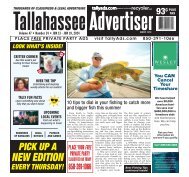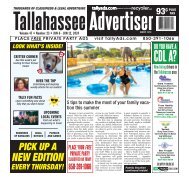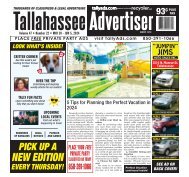Create successful ePaper yourself
Turn your PDF publications into a flip-book with our unique Google optimized e-Paper software.
THETRUCKER.COM OCTOBER 2022 • 15<br />
BUSINESS<br />
SAFETY SERIES<br />
Things that go bump:<br />
Unusual noises or<br />
movements could mean<br />
something needs attention<br />
CLIFF ABBO<strong>TT</strong> | SPECIAL CORRESPONDENT<br />
The phrase “things that go bump in the<br />
night” may sound like a title for a horror movie,<br />
or even a cheesy writing contest, but can<br />
also indicate a warning for those who drive<br />
trucks.<br />
While traveling down the road, most drivers<br />
get pretty tuned in to the sounds heard in<br />
the cab — the hum of the engine, the sound of<br />
tires on pavement, maybe air leaking through<br />
a window channel. Most truckers can instantly<br />
discern a sound or a feeling that isn’t “right”<br />
— something that’s not the norm. The same is<br />
true when the vehicle is parked at a truck stop<br />
or other location.<br />
While driving, “bumps” can indicate running<br />
over an object in the roadway. It’s always<br />
best for a driver to see objects, including<br />
roadway defects such as potholes, before hitting<br />
them, but hat can be hard to do at night,<br />
when it’s harder to identify small objects until<br />
it’s too late. Objects in the roadway can<br />
include trash, parts or cargo that have fallen<br />
from another vehicle, or just about anything.<br />
In addition, many animals are active at<br />
night and sometimes wander onto the road.<br />
Some may be simply crossing, while others<br />
are seeking warmth in the pavement or something<br />
to eat (such as road kill or even salt).<br />
Whatever their reason for being there, creatures<br />
can be hard to spot until it’s too late. If<br />
the driver is checking mirrors or gauges, the<br />
first indication of an animal or object in the<br />
road could be a “ka-thump” that is both heard<br />
and felt.<br />
Feeling bumps while driving can also indicate<br />
a mechanical problem. Parts can vibrate<br />
loose or break, falling off at the worst<br />
possible time. Belts and hoses can break, tires<br />
can sling pieces of tread, and internal components<br />
of engines and transmissions can<br />
come apart. Drivers who hear something that<br />
sounds wrong — or even just different — will<br />
want to find a safe location to pull over and<br />
check for problems.<br />
At night, finding a safe place to stop and<br />
check can be a difficult task. Road shoulders<br />
aren’t safe in the best of conditions, and<br />
they often contain debris that’s been worked<br />
outward from the travel lanes by passing vehicles<br />
— and could now cause more damage<br />
to yours. When possible, a well-lit parking lot<br />
with other people around is the safest bet.<br />
Wherever you stop, carefully observe your<br />
surroundings before getting out of the truck,<br />
and periodically after that. Don’t get so focused<br />
on finding the source of the noise that you become<br />
vulnerable to an attack. By the way, every<br />
driver should have a quality flashlight on hand.<br />
When parked at a truck stop or rest area,<br />
it can be more difficult to identify “strange”<br />
noises. The sound of an idling engine, a running<br />
auxiliary power unit (APU) or a fan for<br />
heat or air conditioning can mask a lot of<br />
sounds outside the truck. Even the sound of<br />
closing truck doors or people talking can become<br />
“normal” if you’re there long enough to<br />
get used to it.<br />
Many drivers are instantly alert when<br />
someone steps up onto their truck, even if<br />
they don’t try to get in. Someone opening the<br />
back doors on the trailer can cause enough<br />
movement in the tractor to wake the driver.<br />
Someone climbing into the trailer or jumping<br />
out can cause even more movement.<br />
It’s an unfortunate fact that some people<br />
at the truck stop sometimes do things to<br />
sabotage trucks, like pull fifth-wheel release<br />
handles or steal fuel, wheels or other objects.<br />
It pays to be alert.<br />
If you hear or feel something suspicious,<br />
always carefully check around your truck<br />
and trailer before opening any doors. Criminals<br />
can easily hide behind the tractor or directly<br />
in front, pushing or shaking the tractor<br />
hard enough for a driver inside to feel it and<br />
then ambushing the driver as he or she exits<br />
the cab to investigate.<br />
Years ago, one unfortunate driver was<br />
woken up by someone pounding on the door,<br />
who said that he hadn’t pulled in far enough<br />
to allow another tractor use the space behind.<br />
Unbeknownst to that driver, thieves<br />
had positioned boards under the inside tires<br />
of each axle. The driver only moved a few feet,<br />
but it was enough to drive onto those boards,<br />
raising the dual tires enough for thieves to<br />
remove the outside wheels and tires. That<br />
driver went to bed with an 18-wheeler and<br />
woke up with a 10-wheeler and a story to tell<br />
his safety department.<br />
If you suspect someone is lurking around<br />
your truck, it’s a good idea to call the police<br />
or truck stop security rather than confronting<br />
the person yourself. It never hurts to at<br />
least have a second set of eyes on whatever<br />
is happening. In a worst-case scenario, you<br />
could be harmed in a confrontation — and<br />
no one would know to call for help. Remember<br />
the adage that no load of freight is worth<br />
your life.<br />
Those occasional bumps and sounds will<br />
probably turn out to be harmless, but by paying<br />
close attention and checking it out when<br />
necessary, you can increase your chances<br />
of bumping the dock at your next pickup or<br />
delivery. 8<br />
iStock Photo<br />
When stopping to investigate an odd sound, bump or vibration, drivers should carefully observe their surroundings<br />
before getting out of the truck, and periodically after that. Focusing only on finding the source of a noise can<br />
leave the driver vulnerable to attack.<br />
MCCOLLISTER’S AUTO TRANSPORT<br />
Fleet expansion<br />
Opportunities available for<br />
OWNER OPERATORS &<br />
COMPANY DRIVERS.<br />
McCollister’s enclosed auto<br />
transport fleet is continuing to<br />
grow due to OUR CLIENTS<br />
AND OUR TALENTED<br />
DRIVERS.<br />
FOR MORE INFORMATION CALL:<br />
JOE CSIK, DRIVER SUPPORT<br />
609-526-9490 OR<br />
DANIEL MARCHESE<br />
609-331-4258<br />
WWW.MCCOLLISTERS.COM

















